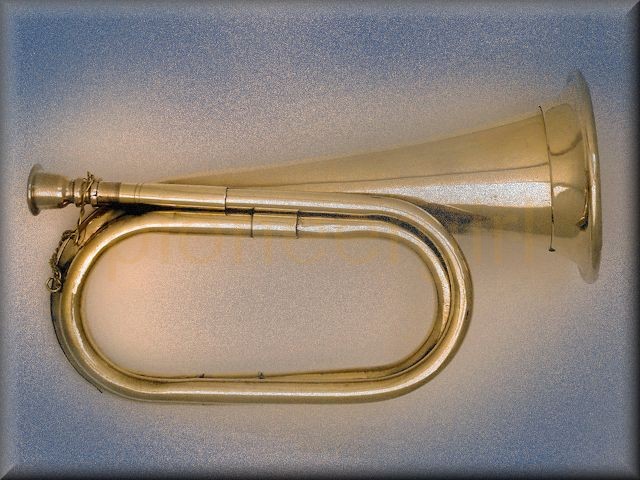Army bugle

A musical wind instrument used in hunting or for military music. — Webster, 1882
 We went to a dance at Grandpa Ingalls’ house in the Big Woods and Uncle George blew his bugal [sic] for us. – Pioneer Girl
We went to a dance at Grandpa Ingalls’ house in the Big Woods and Uncle George blew his bugal [sic] for us. – Pioneer Girl
 There is no proof that Laura Ingalls Wilder’s uncle, George Whiting Ingalls, served or tried to enlist in the Union Army in any capacity. Anyone who speculates that “George A. Ingalls” who served in the Twentieth Wisconsin Infantry (according to the online roster of Wisconsin volunteers)was Laura’s uncle can NOT have looked at the records on file for this person at the National Archives, where he is listed as twenty-three years of age at enlistment, on July 10, 1862… (plus more…). George Whiting Ingalls was born July 15, 1851, and on the date given he would have been a week shy of his eleventh birthday. Trust me. We can put this one to rest for good; George A. Ingalls was not Uncle George from Little House in the Big Woods!
There is no proof that Laura Ingalls Wilder’s uncle, George Whiting Ingalls, served or tried to enlist in the Union Army in any capacity. Anyone who speculates that “George A. Ingalls” who served in the Twentieth Wisconsin Infantry (according to the online roster of Wisconsin volunteers)was Laura’s uncle can NOT have looked at the records on file for this person at the National Archives, where he is listed as twenty-three years of age at enlistment, on July 10, 1862… (plus more…). George Whiting Ingalls was born July 15, 1851, and on the date given he would have been a week shy of his eleventh birthday. Trust me. We can put this one to rest for good; George A. Ingalls was not Uncle George from Little House in the Big Woods!
Since it is known that two of Laura’s Ingalls uncles, Hiram and James, did serve in the Civil War, one wonders why no one speculates that it was Hiram Ingalls who was viewed as the “wild” uncle, since Hiram isn’t mentioned in any Little House book or version of Pioneer Girl. After the War, Hiram spent his life as a trapper and trader in the Wisconsin woods. Another question you don’t see asked is why someone who ran away as a child to be a drummer boy is hanging around a dance playing a bugle as an adult, and why he’s wearing an Army uniform years after the war, as the drawing by Garth Williams suggests. There were, of course, young boys who ran away to join the Union Army, as well as young buglers and young drummer boys.
The most common type of bugle used during the Civil War was about seventeen inches long, made of copper and/or brass, and was tuned to play in the key of C. Most were imported from Europe. These bugles had only one “twist” or loop of brass, as shown in the photo above. For more information about early bugles and collecting them, see tapsbugler.com.
The Revised United States Army Regulations of 1861 (with updates that made the regulations current through late July 1863) includes the following:
The general superintendent will cause such of the recruits as are found to possess a natural talent for music, to be instructed (besides the drill of the soldier) on the fife, bugle, and drum, and other military instruments; and boys of twelve years of age, and upward, may, under his direction, be enlisted for this purpose. But as recruits under eighteen years of age and under size must be discharged, if they are not capable of learning music, care should be taken to enlist those only who have a natural talent for music, and, if practicable, they should be taken on trial for some time before being enlisted. (page 138)
Bugle calls were first used during the Revolutionary War, and by the end of the Civil War the artillery, cavalry, and infantry were all using specific bugle calls as signals for specific behaviors to be executed – to rise in the morning, end drill, eat, lights out at night, etc. The year Laura Ingalls was born, these became standardized for all branches of the United States Army. Listen to the playing of “Taps” HERE. It’s not hard to imagine Laura Ingalls hearing the long, clear note played at the end, no matter who was playing it or if it just made for a really nice part of the story.

bugle (BW 8; FB 16; THGY 13; PG)
army (BW 8; THGY 13; PG)
echo of (BW 8)

